 The jewelry makers in Kievan Rus’ were amazingly skilled. And their production was in a great demand. You can’t imagine the finished outfit of a local woman without jewels. We tried to gather as much interesting info about jewelry pieces of Kievan Rus’ as possible. From this article, you’ll find out what is skan’ and zern’, what jewels did Medieval people wear, and what designs of jewelry were the most popular. Also, you’ll learn why stone-set rings of the period lost their stones so easily. And much more.
The jewelry makers in Kievan Rus’ were amazingly skilled. And their production was in a great demand. You can’t imagine the finished outfit of a local woman without jewels. We tried to gather as much interesting info about jewelry pieces of Kievan Rus’ as possible. From this article, you’ll find out what is skan’ and zern’, what jewels did Medieval people wear, and what designs of jewelry were the most popular. Also, you’ll learn why stone-set rings of the period lost their stones so easily. And much more.
Kievan Rus’ is the first state of the Eastern Slavs. Its capital was in Kyiv (today, it is the capital of Ukraine). Kievan Rus’ existed between the end of the 9th and the middle of the 13th century. At its zenith, it included the territory from the Carpathian Mountains to the Volga River, and from the Black Sea to the Baltic Sea. This state was very developed and rich in folk crafts: pottery, armor and weapon making, weaving, jewelry making, etc. Many of the artifacts from Kievan Rus’ are considered national treasures and are now kept in Ukrainian museums.
As Kievan Rus’ was a rich and developed state, local people used a lot of jewels and different adornments. You can’t imagine the finished outfit of a local woman without jewels. Wealthier citizens wore gold, silver, and glass jewelry, often decorated with semi-precious stones. Poorer people used jewels made from bronze, glass, clay, etc.
Silver jewels often served as money. That’s why some of them were plain – didn’t have any patterns or embellishments. Such thick necklaces or bracelets, made from pure silver, could be given as payment. Its financial value was determined by weight. If the owner needed to spend only part of the full value of the jewelry, he or she cut and gave away a piece of the bracelet or necklace and left the rest to him/herself. Here is an example of such jewels – silver women’s bracelet. This piece is still whole and undamaged.
There were male and female traditional jewelry pieces. And they differ much from each other. As you will find out below.
Jewelry making techniques of Kievan Rus’
The jewelry makers of the time were very skilled. Just imagine, they produced handmade jewels with delicate and elaborate decorations and did it about a 1,000 years ago. And already they had many different techniques, including metalsmithing, wiring, soldering, casting, etc.
But the main techniques that represent Kievan Rus’ and its silversmiths are filigree (called “skan’”) and “zern’” (solder for making tiny metal grains).
These techniques are very complicated because the jewelry maker uses tiny silver wires and grains or dots of silver to create a pattern. It is a time-consuming labor that needs a lot of care concentration.
Here, you can see a silver bead that is embellished with both skan’ and zern’ methods. The small dots in the center of the bead are zern’ – each dot of melted silver is put there separately. On the ends of the bead, you can see the skan’ – a teeny-tiny silver wire is soldered to the body of the bead.
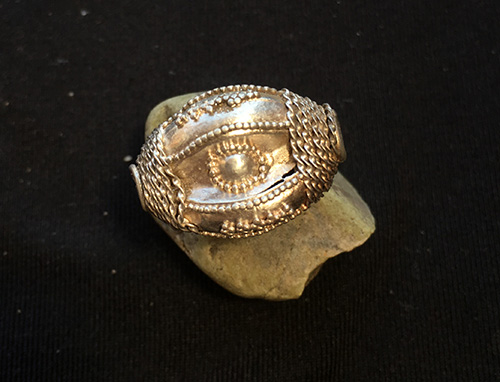
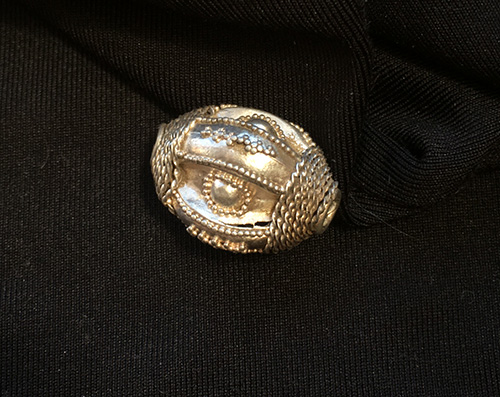
Silver bead decorated with skan’ and zern’. Early Kievan Rus'. Original piece
Similar zern’ is also seen on the silver crescent-shaped pendant. Compare with gold-gilded pendants where the dots are made by simple casting.
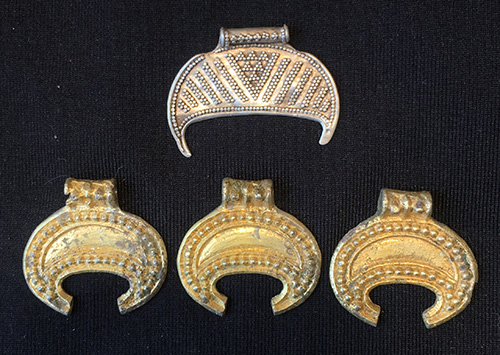
Silver and silver + gold-gilding crescent-shaped pendants. Early Kievan Rus'. Original pieces
Male and female necklaces
There were hundreds of variations of necklaces used by people in Kievan Rus’. Men mostly wore necklaces or torques called “grivna”. They were made from solid silver (less often, from other precious metals). Grivna could be a plain piece of metal or it could be decorated with engraved patterns. It could also have an intricate shape. For men, grivna was an attribute of a warrior.
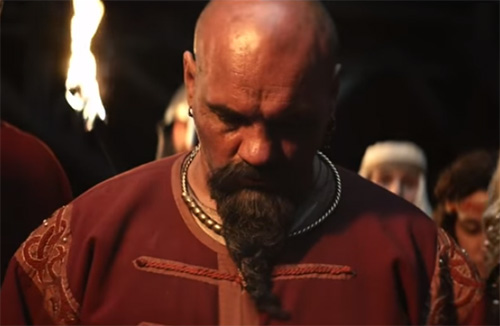
Male silver necklace called “grivna” on a warrior. From Ukrainian movie The Stronghold
Female necklaces were different. Though, women could also wear grivna – of a little different design: more delicate and embellished. But they preferred necklaces made from beads, coins, and pendants. Such necklaces looked extraordinary – rich and festive. They could be made from gold or silver elements, glass pieces, semi-precious stones, etc. Among the most popular, were necklaces made from silver coins and silver beads. Kievan Rus’ didn’t make its own coins during most of its history (only some princes had their coinage), so people used Arab coins that were widely in use in Kievan Rus’.
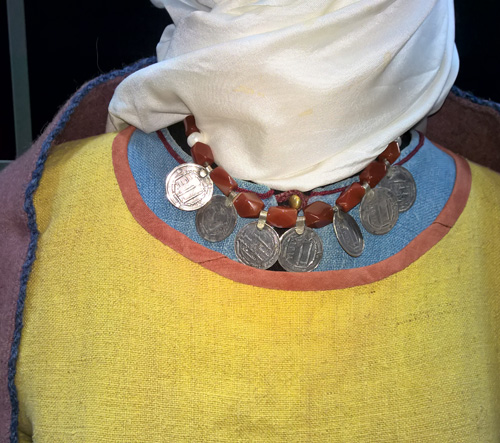
Female necklace made from stones and silver coins. The 10th century. Reconstruction
Beads for the necklaces were metal (most often, silver), glass beads (were rather expensive), stone beads, or even clay beads. Of course, silver beads were the most intricate and striking. The thinnest and lightest silver beads could be decorated with elaborate patterns. In one necklace, there could be used beads of various design – there were no rules, no uniformity. It was ok to have, let’s say, 6 beads: 4 of them are identical and the other 2 are of totally different designs.
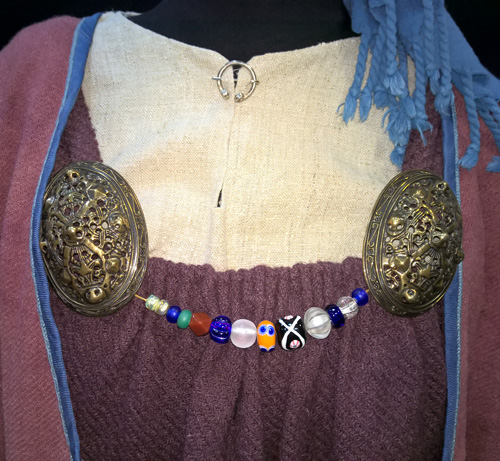
Colorful glass beads. The 10th century. Reconstruction
In the photo below, you can see such a necklace with various silver beads and Arab coins. The coins, as well as the beads actually, are of different size. There is a large central coin. Also, you can see the holes in some of the coins – it means that they were used in several jewelry pieces before becoming a part of this particular necklace.
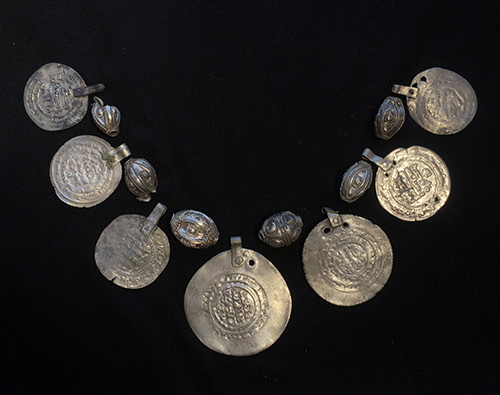
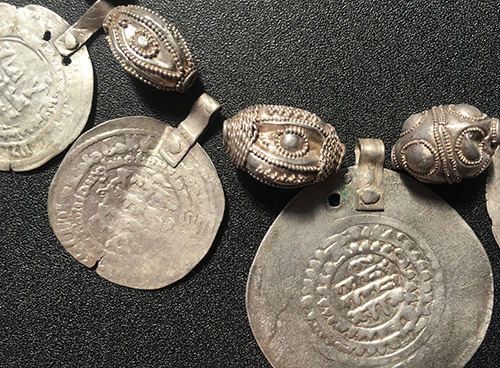
Female necklace that consists of coins (the 10th century) and beads. Early Kievan Rus'. Original piece
Earrings and temple rings
The people of Kievan Rus’ liked earrings and temple rings very much. Though, earrings could be worn by both men and women – males wore only one, while females used a pair. Pretty much like we are used to having in modern days.
But the temple rings were a prerogative of women. These pieces are similar to the earrings but they could be worn not only in the ears but attached to the hair or a headdress. You didn’t have to pierce your ears to use temple rings.
 Temple rings attached to the headband. From Ukrainian movie The Stronghold
Temple rings attached to the headband. From Ukrainian movie The Stronghold
And, of course, there were dozens of various designs of earrings and temple rings. They could look like simple spirals or rings made from wire. They could have elaborate shape, like semi-sun or moon or flower. They could be attached right to the hair or headpiece or hang on a long chain / a row of beads. But the typical design of earrings and temple rings in Kievan Rus’ is a 3-beaded ring. It consists of a simple wire hoop (silver, gold, or bronze) and 3 intricate metal beads. The shape and design of beads could be diverse. But, usually, all the 6 beads on a pair of earrings or temple rings were of a single design.
Here you are a sample of temple rings typical of the Kyiv region. Their hoops are rather thick, so it would be hard to put them into the ears (though, people often had large holes pierced in their ears). These temple rings have very delicately and skillfully made beads – extraordinarily fine work. They are made of bent silver wire with dots of silver to reinforce the construction. And each bead used to spin freely on the ring, so they quivered and tinkled when the woman moved.
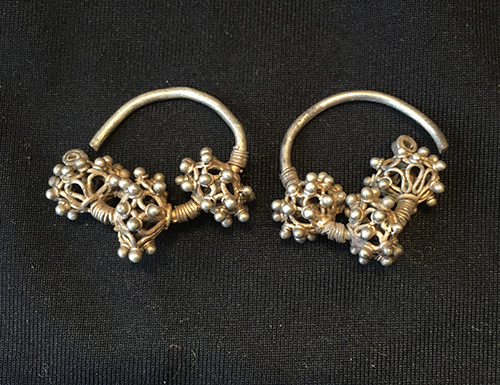
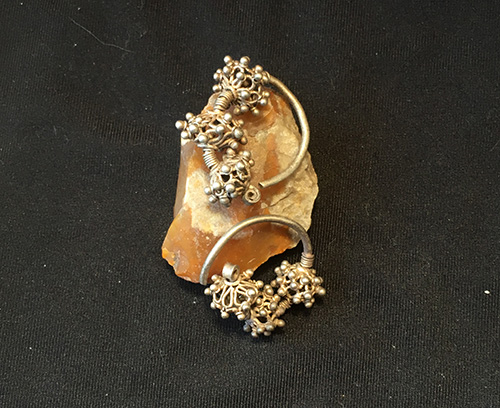
Silver 3-beaded temple rings. Early Kievan Rus'. Original pieces
Bracelets
Men and women both wore bracelets. There were many various designs and shapes of these pieces. The favorite materials for the bracelets were silver, gold, bronze, and glass. They were often made from one solid piece of metal and decorated with patterns, or no patterns at all. Also, there were bracelets made from precious metal wire. The most beautiful bracelets were the shaped ones – for example, a bracelet made in the shape of a snake or dragon. Another variation of this jewelry is wide bracelets made from thin silver and richly patterned. Women in Kievan Rus’ also liked thin bracelets made from colorful glass.
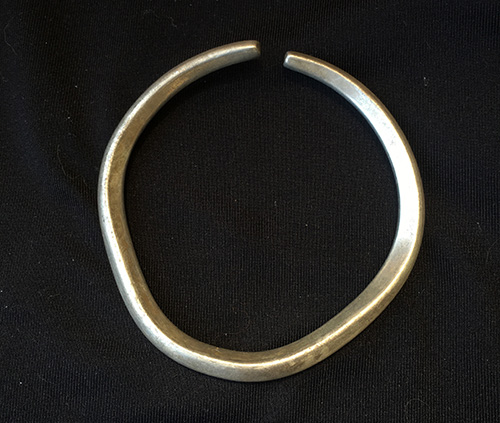
Heavy silver bracelet without any embellishments. Early Kievan Rus'. Original piece
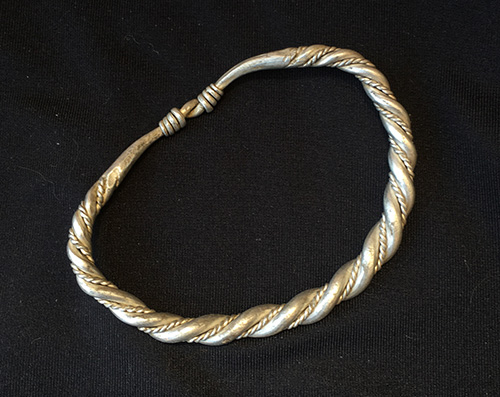
Silver bracelet made using a wiring technique. Early Kievan Rus'. Original piece
Rings
People in Kievan Rus’ used a lot of rings. Men preferred ring seals, while women liked circlet rings and stone-set rings. As with the necklaces, in those times, people didn’t have any etiquette rules or anything, regarding the number of rings and blending different designs. You could wear 10 rings, one per each finger, designed diversely and from different materials and still look normal.
Here are two samples of vintage rings from Kievan Rus’: a ring decorated with engraved patterns and blackening and a stone-set ring. The last one has lost its stone at some point. And that’s because in Kievan Rus’ jewelers used another technology of setting stones into metal jewelry: you can see the very thin silver foil that kept the stoned in place. Of course, such foil was fragile and often broke, which caused the loss of a stone. Modern jewelers use bits of gold or silver wire to keep the stone in place – and that is much more reliable.
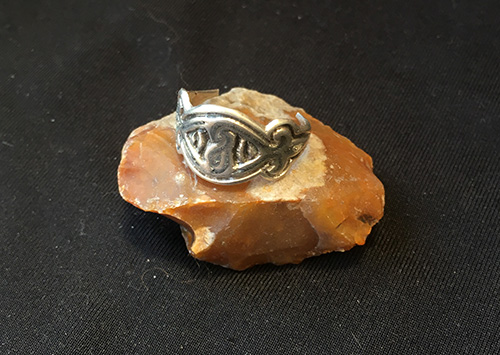
Women’s silver ring decorated with engraved patterns and blacking. Early Kievan Rus'. Original piece
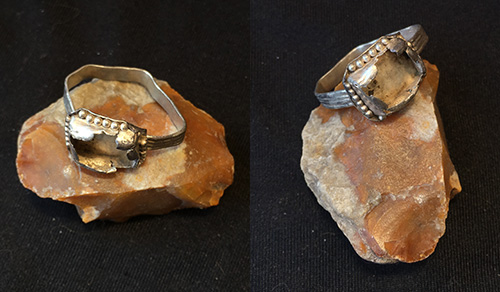
Silver stone-set ring without the stone. Early Kievan Rus'. Original piece
Crescent-shaped pendants
These pendants were very popular in Kievan Rus’ and even long before it. Crescent-shaped pendants are female jewelry – they symbolize fertility and femininity. These jewelry pieces were usually made from silver, bronze, and less often from gold. Crescent-shaped pendants could be worn on a long chain or thread around the neck or they served as adornments for the women’s costume – were stitched to the fabric.
In the photo below, you can see 4 crescent-shaped pendants. All of them are made from silver but 3 pendants are gold-gilded. The jewelry makers of Kievan Rus’ gilded their jewels not using an electrolysis method (as it is made today) but dipped the piece into melted gold.
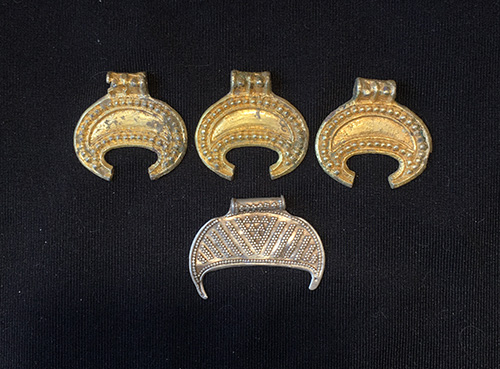
Silver and silver + gold-gilding crescent-shaped pendants. Early Kievan Rus'. Original pieces
Belt plates and buckles
Medieval belts were often adorned with ornate plates and had elaborate buckles. The shapes, sizes, designs, and patterns of these jewelry pieces were various. They served both as a decoration and a functional item.
For example, here you are several silver belt plates. They have a teardrop shape. Some of them are thin and plain, others are thicker and are embellished with a simple pattern.
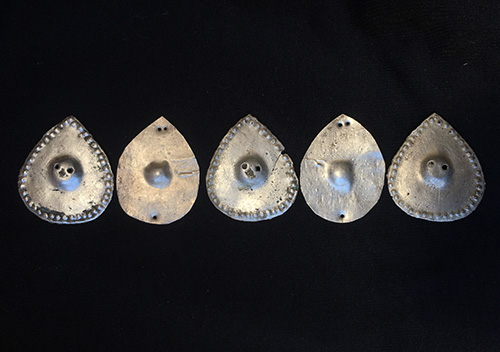
Silver belt or bag plates. Early Kievan Rus'. Original pieces
Brooches (fibulas) and other clasps
And one more popular jewelry piece in Kievan Rus’ is a brooch or clasp. There were many different clasps used by men and women. Some of them were a little bit similar to Roman fibulas, others had a totally different design. They were used to pin the flaps of a cloak or shawl, to button-down the garments, etc. Ordinary men used simple and plain bronze brooches, while women and wealthy males and females could wear ornate silver or gold pieces.
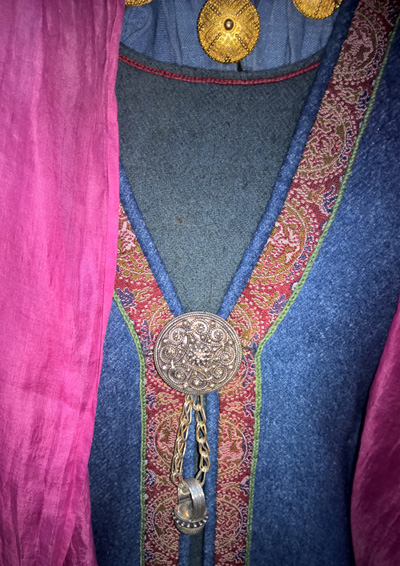
Silver brooch on the clothing. The 10th century. Reconstruction


